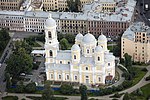St Petersburg Classical Gymnasium

St Petersburg Classical Gymnasium is a coeducational public school (# 610) established in 1989 in Saint Petersburg, Russia. It is one of the innovative independent schools created in St Petersburg after the collapse of the Soviet Union (See Literature). Formally gymnasium consists of two institutions: secondary school (from 5th to 9th grades) and high school (10th and 11th grades). Up until 2011 there were two classes (around 50 students) enrolled every year, but since then three classes (around 75 students) are formed in the 5th grade. The mission of the school is to teach students how to learn, to develop independent analytical thinking and strengthen their interest in acquiring new knowledge. The school lays an emphasis on ancient languages and maths.
Excerpt from the Wikipedia article St Petersburg Classical Gymnasium (License: CC BY-SA 3.0, Authors, Images).St Petersburg Classical Gymnasium
Krasnogo Kursanta Street, Saint Petersburg Petrograd Side (Петровский округ)
Geographical coordinates (GPS) Address Nearby Places Show on map
Geographical coordinates (GPS)
| Latitude | Longitude |
|---|---|
| N 59.955 ° | E 30.291944444444 ° |
Address
Krasnogo Kursanta Street 6/9
197198 Saint Petersburg, Petrograd Side (Петровский округ)
Saint Petersburg, Russia
Open on Google Maps








